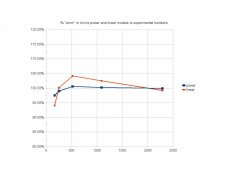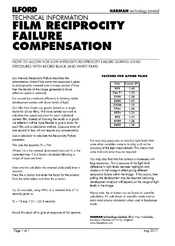I've been playing around with Bond's data a bit more today, and moved from Curve Expert to QtiPlot under linux (it's also freely available for Mac and MS Windows if you install the necessary QT environment on those platforms).
I've been looking at the consequences of adding the metered time to a log equation as Gainer does in his formula.
Covington notes that the Schwarzschild formula accommodates the approximate logarithmic character of reciprocity failure, but is a good fit only at longer exposures. So Covington modifies the formula as follows.
where t = time in seconds
and 'p' is the Schwarzschild exponent, which varies between about 0.50 and 1.00, with 1.00 being perfect reciprocity.
Schwarzschild
actual speed = rated speed * t^(p-1)
Covington
actual speed = rated speed * (t+1)^(p-1)
When this equation is manipulated to produce adjusted exposure times, one gets
corrected time = (metered time +1)^(1/p)-1
In the same way, Gainer's formula , where 'a' is a coefficient dependent on film type,
corrected time = metered time ^ 1.62 * a + metered time
is a better fit than the straight log fit because it makes the correction relative to the initial value.
Gainer's formula can be rewritten as
y=a*x^b+x
where 'b' is a constant with a value of 1.62
and 'a' is a variable coefficient, dependent on the film behavior
compare this to a straight log fit
y=a*x^b
where 'a' is a variable coefficient
and 'b' is a variable exponent
Taking the cue from Covington and Gainer, one can add the value of x (which is the metered exposure time) to the straight log fit as follows
y=a*x^b+x
or
corrected time in seconds = a * metered time ^ b + metered time
The only difference between this model and Gainer's is that 'b' becomes a variable exponent rather than a constant exponent equal to 1.62, and this equation can be plugged into a curve fitting program like QtiPlot and regressed. So this is just a more generalized form of Gainer's equation to accommodate films that might not "believe in" Gainer's constant (as Pat puts it) for the exponent. BTW, it hasn't been mentioned in this thread, but that constant is also known as phi, the golden ratio, and is also the ratio in the Fibonacci series and many natural phenomena.
Making the Gainer adjustment (adding in the metered time) to a standard log fit generally makes for a better fit to the Bond data, especially with time exposures at the shorter end of the spectrum.
Doing just that with QtiPlot produces the following values when regressing Bond's data using the formula y=a*x^b+x All values but one hit within +/- 20% of Bond's data. TMY is actually a somewhat better fit to a straight log function. (R^2 and Chi^2 values are shown, but one must keep in mind that tweaking to optimize R^2 with data containing sufficient randomness can lead to silly numbers. See
http://www.statisticalengineering.com/r-squared.htm )
===========================================
Bond Data Modified Power fits using QtiPlot
using function: y=a*x^b+x
where: y = adjusted time in seconds
x = metered time in seconds
TMX
a = 0.040427011642017
b = 1.7298680795766
Chi^2/doF = 3.5603085938797e+00
R^2 = 9.9995145162988e-01
TMY
a = 0.18601192358624
b = 1.3478556218539
Chi^2/doF = 1.9330084508589e+00
R^2 = 9.9994757744607e-01
100 Delta
a = 0.056981442009898
b = 1.5754970970282
Chi^2/doF = 2.4755726666553e+00
R^2 = 9.9993698631413e-01
HP5+
a = 0.029331463486986
b = 1.8845746981645
Chi^2/doF = 1.8558446352135e+02
R^2 = 9.9883106078538e-01
Tri-X
a = 0.20711252730778
b = 1.5186636391859
Chi^2/doF = 9.3638439358780e+01
R^2 = 9.9936933497974e-01
=============================================
I'll attach a revised .pdf with the modified log regressions from Bond's data. You can easily build your own chart in a spreadsheet using your own data and regressions.
For those without much spreadsheet experience, the following functions are standard in spreadsheets and flat ascii representations of formulae:
the carat ^ in y^x means "raised to the power", y raised to the power of x
the asterisk * is a multiplier, e.g. 3*2=6 This is to avoid confusion between any variable 'x' and the common handwritten "x" as a multiplier.
Don't include spaces in your spreadsheet formula. I've only done that in this post for human readability.
If you can't afford MS Office, openoffice.org has a completely free office suite that runs natively in linux, under MS Windows, and the new version 3.0 is now native on the Mac OS-X. openoffice will also create .pdf files.
Lee
P.S. After posting I went back and calculated the average value of the exponent b in the regressions of Bond's data using the modified power equation.
It's 1.61113







 - how does one perform the function "^"?
- how does one perform the function "^"?
 Or am I dreaming here? You could win the APUG Nobel prize and be heroes with such a product...I forsee fame, endorsment deals, talk shows, ...groupies...
Or am I dreaming here? You could win the APUG Nobel prize and be heroes with such a product...I forsee fame, endorsment deals, talk shows, ...groupies...
